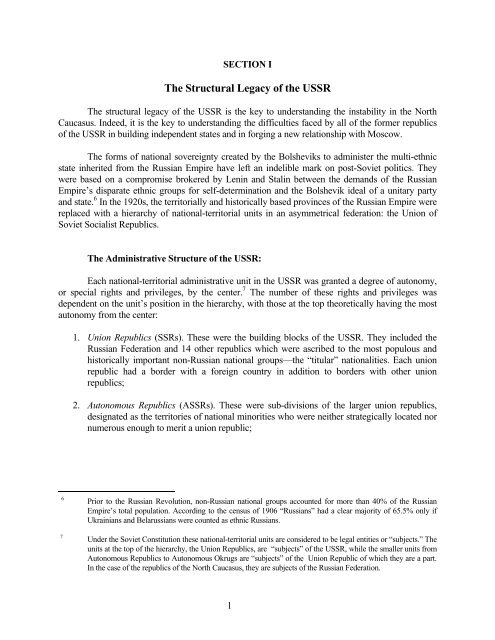RUSSIA'S TINDERBOX - Belfer Center for Science and International ...
RUSSIA'S TINDERBOX - Belfer Center for Science and International ...
RUSSIA'S TINDERBOX - Belfer Center for Science and International ...
Create successful ePaper yourself
Turn your PDF publications into a flip-book with our unique Google optimized e-Paper software.
SECTION I<br />
The Structural Legacy of the USSR<br />
The structural legacy of the USSR is the key to underst<strong>and</strong>ing the instability in the North<br />
Caucasus. Indeed, it is the key to underst<strong>and</strong>ing the difficulties faced by all of the <strong>for</strong>mer republics<br />
of the USSR in building independent states <strong>and</strong> in <strong>for</strong>ging a new relationship with Moscow.<br />
The <strong>for</strong>ms of national sovereignty created by the Bolsheviks to administer the multi-ethnic<br />
state inherited from the Russian Empire have left an indelible mark on post-Soviet politics. They<br />
were based on a compromise brokered by Lenin <strong>and</strong> Stalin between the dem<strong>and</strong>s of the Russian<br />
Empire’s disparate ethnic groups <strong>for</strong> self-determination <strong>and</strong> the Bolshevik ideal of a unitary party<br />
<strong>and</strong> state. 6 In the 1920s, the territorially <strong>and</strong> historically based provinces of the Russian Empire were<br />
replaced with a hierarchy of national-territorial units in an asymmetrical federation: the Union of<br />
Soviet Socialist Republics.<br />
The Administrative Structure of the USSR:<br />
Each national-territorial administrative unit in the USSR was granted a degree of autonomy,<br />
or special rights <strong>and</strong> privileges, by the center. 7 The number of these rights <strong>and</strong> privileges was<br />
dependent on the unit’s position in the hierarchy, with those at the top theoretically having the most<br />
autonomy from the center:<br />
1. Union Republics (SSRs). These were the building blocks of the USSR. They included the<br />
Russian Federation <strong>and</strong> 14 other republics which were ascribed to the most populous <strong>and</strong><br />
historically important non-Russian national groups—the “titular” nationalities. Each union<br />
republic had a border with a <strong>for</strong>eign country in addition to borders with other union<br />
republics;<br />
2. Autonomous Republics (ASSRs). These were sub-divisions of the larger union republics,<br />
designated as the territories of national minorities who were neither strategically located nor<br />
numerous enough to merit a union republic;<br />
6 Prior to the Russian Revolution, non-Russian national groups accounted <strong>for</strong> more than 40% of the Russian<br />
Empire’s total population. According to the census of 1906 “Russians” had a clear majority of 65.5% only if<br />
Ukrainians <strong>and</strong> Belarussians were counted as ethnic Russians.<br />
7 Under the Soviet Constitution these national-territorial units are considered to be legal entities or “subjects.” The<br />
units at the top of the hierarchy, the Union Republics, are “subjects” of the USSR, while the smaller units from<br />
Autonomous Republics to Autonomous Okrugs are “subjects” of the Union Republic of which they are a part.<br />
In the case of the republics of the North Caucasus, they are subjects of the Russian Federation.<br />
1
















